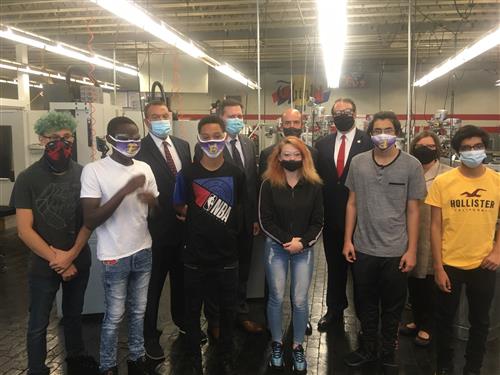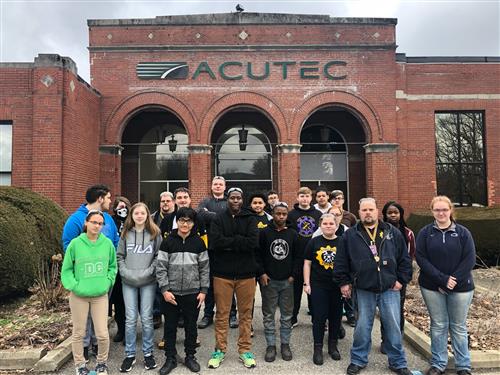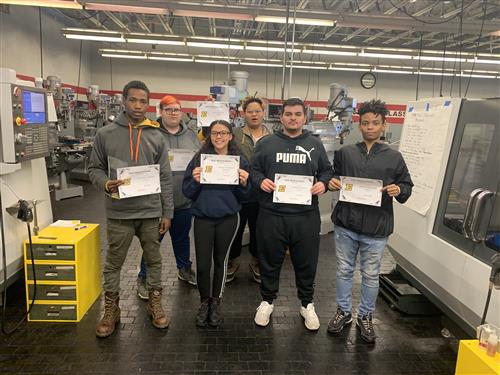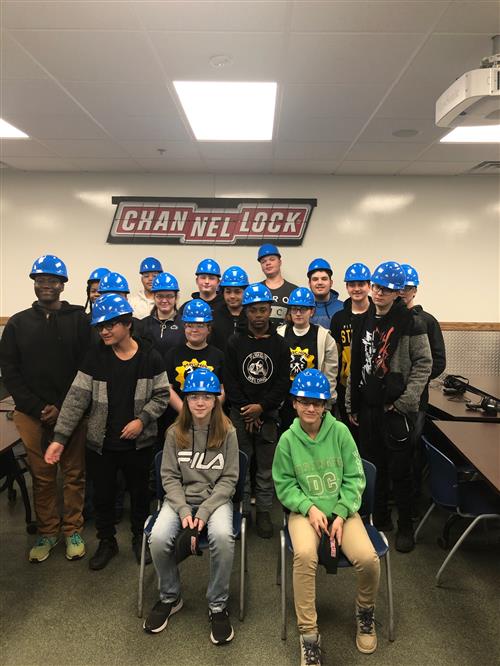Machine Trades (Manual & CNC)
Page Navigation
- Erie High School
- Overview
-
Machine Trades
United States Secretary of
Labor Eugene Scalia visits Erie High




CIP Code: 48.0501 Machine Tool Technology/Machinist
Pathway: Engineering and Industrial Technology
Instructor: Greg WetzelLength: 5 yearsInstructor: Scott DudkiewiczLength: 1 yearCertifications: OSHA 10, S/P2, NIMS (National Institute for Metalworking Skills) Level 1- Measurement, Materials, and Safety; Planning, Benchwork and Layout, Drill Press, Grinding, Manual Mill, Manual Lathe, CNC Mill, CNC Turning, Turning Between Centers, Turning with Chucking
As of December 2019, this program is an officially Pennsylvania state registered pre-apprenticeship program! Any industry certifications earned by students can be applied toward requirements for a registered apprenticeship program, reducing the amount of time for students spent training and reducing training cost to employers.
Overview
Work in the machine tool trades incorporates a high degree of precision in the creation of various parts, fixtures and products utilized in the industry. Once primarily a metalworking trade, tool and die machining is now included in the plastics and wood industries. Almost all products used today have been influenced by the tool and die industry. From design specification and drawings, skilled workers in the tool and die/machine trades utilize power machining tools, hand tools, and computer-driven machines to create desired products.Introduction - Program of StudyMachinists use machine tools, such as lathes, milling machines, and machining centers, to produce precision metal parts. Although they may produce large quantities of one part, precision machinists often produce small batches or unique items. They use their knowledge of the working properties of metals and their skill with machine tools to plan and carry out the operations needed to make machined products that meet precise specifications.
Some machinists, often called production machinists, may produce large quantities of one part, especially parts requiring the use of complex operations and great precision. Frequently, machinists work with computer control programmers to determine the manner in which the automated equipment will cut.
Because the technology of machining is changing rapidly, machinists must learn to operate a wide range of machines. Some newer machines use lasers, water jets, or electrified wires to cut the product. While some ofthe computer controls are similar to other machine tools, machinists must understand the unique cutting properties of these different machines. As engineers create new types of machine tools and new materials to machine, machinists must constantly learn new machining properties and techniques.
Many machinists work a 40 hour week. Evening and weekend shifts are becoming more common as companies extend hours of operation to make better use of expensive machines.
In high school, students should take math courses, especially trigonometry, and, if available, courses in blueprint reading, metalworking, and drafting. Formal apprenticeship programs, typically sponsored by a union or manufacturer, are an excellent way to learn the job of machinist. Apprentices usually must have a high school diploma, GED, or the equivalent, and most have taken algebra and trigonometry classes. Apprenticeship programs consist of paid shop training and related classroom instruction. In shop training, apprentices may work full time and are supervised by an experienced machinist while learning to operate various machine tools. Classroom instruction includes math, physics, materials science, blueprint reading, mechanical drawing, and quality and safety practices. Apprenticeship classes are often taught in cooperation with local community colleges or vocational technical schools. Many entrants previously have worked as machine setters, operators, or tenders.
To boost the skill level of machinists and to create a more uniform standard of competency, a number of training facilities, state apprenticeship boards, and colleges are implementing curricula that incorporate national skills standards developed by the National Institute of Metalworking Skills (NIMS). After completing such a curriculum and passing practical and written exams, trainees are granted a certificate, recognized as a NIMS credential. Completing a recognized certification program provides a machinist with better career opportunities and helps employers to better judge the abilities of new hires. Journeyman certification can be obtained from state apprenticeship boards after completing an apprenticeship.
Assumptions of this Program of Study
High quality programs should meet the following standards:
1. Promote positive working relationships.
2. Implement a curriculum that fosters all areas of skill development
3. Use appropriate and effective teaching approaches.
4. Provide ongoing assessments of student progress.
5. Employ and support qualified teaching staff.
6. Establish and maintain relationships and use resources of the community.
7. Provide a safe and healthy learning environment.
8. Implement strong program organization and supervision policies that result in highquality teaching and learning.
9. Integrate academic skills and aptitudes necessary for postsecondary education, gainful employment and a foundation of lifelong learning
CIP Code 48.0501 Machine Tool Technology/Machinist
This is an instructional program that prepares individuals to apply technical knowledge and skills in all aspects of shaping metal parts. Instruction involves making computations relating to work dimensions, tooling and feeds and speeds of machining. Emphasis is placed upon bench work and the operation of lathes, power saws, shapers, milling machines, grinders, drills and computer operated equipment (CNC and CIM). Instruction also includes the use of precision measuring instruments such as layout tools, micrometers and gauges; methods of machining and heat treatment of various metals; blueprint reading; and the layout of machine parts. Instruction prepares students to operate all types of hand and computer controlled machines.

